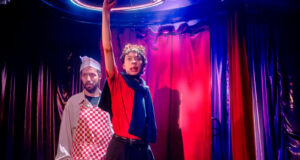Vivid performance carries a somewhat opaque supernatural dramaSummary
Rating
Good
As the audience take their seats, The Rotting Hart begins with a topless young man lying on the floor next to an overturned wooden chair. His skinny body occasionally squirms and spasms as if he’s experiencing some sort of fit. I had no idea what we were being presented with, but it felt intriguingly off-kilter.
When the main action of the play begins, the man describes slaughtering a horse and cutting it up into pieces (mimed upon the form of the chair), distributing them to the audience as tasty morsels. It emerges that we’re in rural Spain in an unspecified period, where the young man lives with his father in a cottage, subsisting on game, in the shadow of a forbidding abandoned monastery.
When a mysterious man named Diego arrives, our protagonist immediately dislikes him; an instinctive repulsion deepened when Diego is given a horse to join a hunt, then moreso when he is given an opportunity to shoot a deer and he misses the beast, thus depriving the family of potential sustenance.
This being a Queer show (part of the King’s Head’s latest takeover season, dubbed ‘A Queer Interrogation’) the antipathy between our nameless hero and Diego can’t last, and sure enough on a night-time jaunt to the monastery lust of a fearful kind blooms between the two men and is consummated. I think it’s at about this time that the protagonist recognises the bud of antlers on Diego’s forehead. Perhaps he then fully transforms into an animal? Perhaps the protagonist becomes a dog, or another sort of animal?
“I don’t understand. I’m tired of not understanding.” So says our hero at one point, and it is a line which I could definitely relate to. The Rotting Hart has the authentic flavour of a gothic folk horror, but why does any of it happen? Is it a consequence of “forbidden love”? Are the transformations into the inhuman supposed to be seen as punishments, or are the characters assuming their natural forms somehow? The blurb describes the show as Brokeback Mountain meets The Fly, but both those films, for all their extraordinary qualities, have clear narratives for the audience to follow. It doesn’t help that much of the reported dialogue in The Rotting Hart is in Spanish, as are some lengthy segments which turn out to be descriptions of sexual-themed legislation over the years. Why introduce a language barrier to an already abstract story?
Daniel Orejon performs his own script, and it’s an exceptionally accomplished performance, very well complemented by an atmospheric lighting and sound design. Orejon’s intense delivery is firmly directed at the audience, and his movements are bold and balletic – and frequently on tip-toe, as if the actor is constantly on the brink of launching himself into space. He’s a bit like a Hispanic Ben Whishaw, which I mean as a positive comparison. There’s also some excellent and imaginative chair work (a niche theatrical form mostly confined to fringe shows), which sees the humble wooden furniture item transformed into the bodies of animals and people, and at one point a shotgun.
But in the end we do need to be able to understand the story we’re being told. It’s a bit of a shame that despite the undeniable talent of the creative team and the passionate commitment of Orejon’s performance, ultimately the script doesn’t invite us into the world of the play with enough clarity for us to be able to really participate in it.
Written by: Daniel Orejon
Directed by: Flavia D’Avila
Technical Manager: Liz March
Produced by: Crested Fools Theatre Company
The Rotting Hart played at the King’s Head Theatre as part of the A Queer Interrogation season, which continues until May 14. Details of the full season can be found here.
 Everything Theatre Reviews, interviews and news for theatre lovers, London and beyond
Everything Theatre Reviews, interviews and news for theatre lovers, London and beyond



